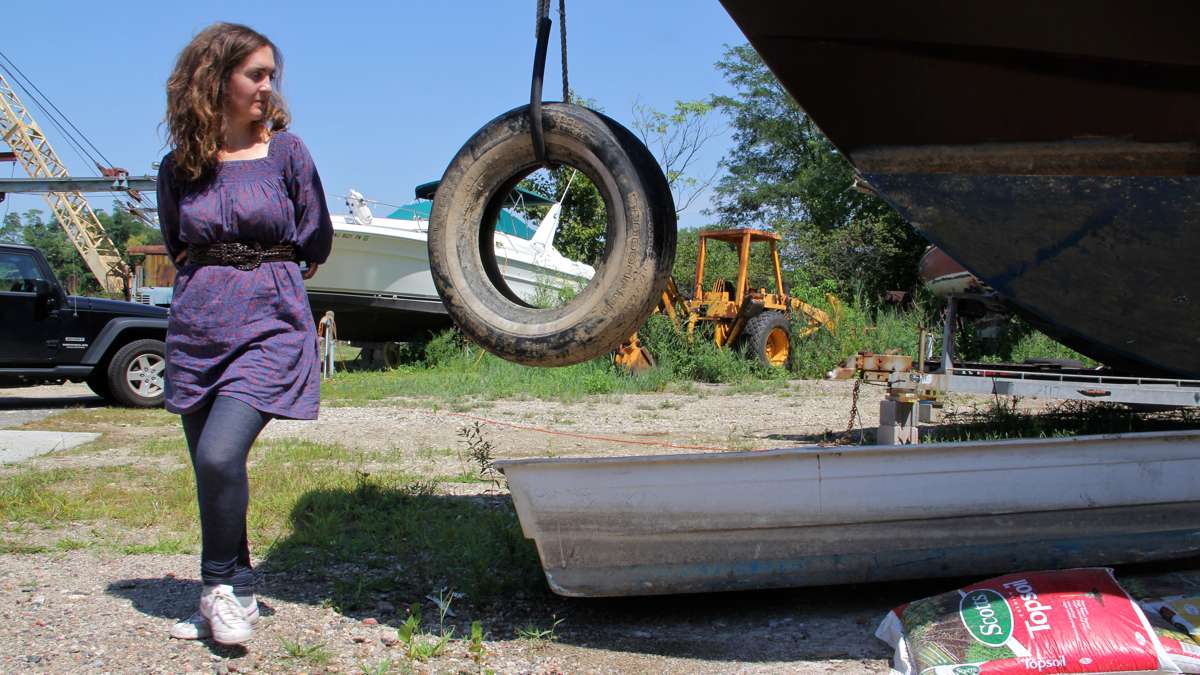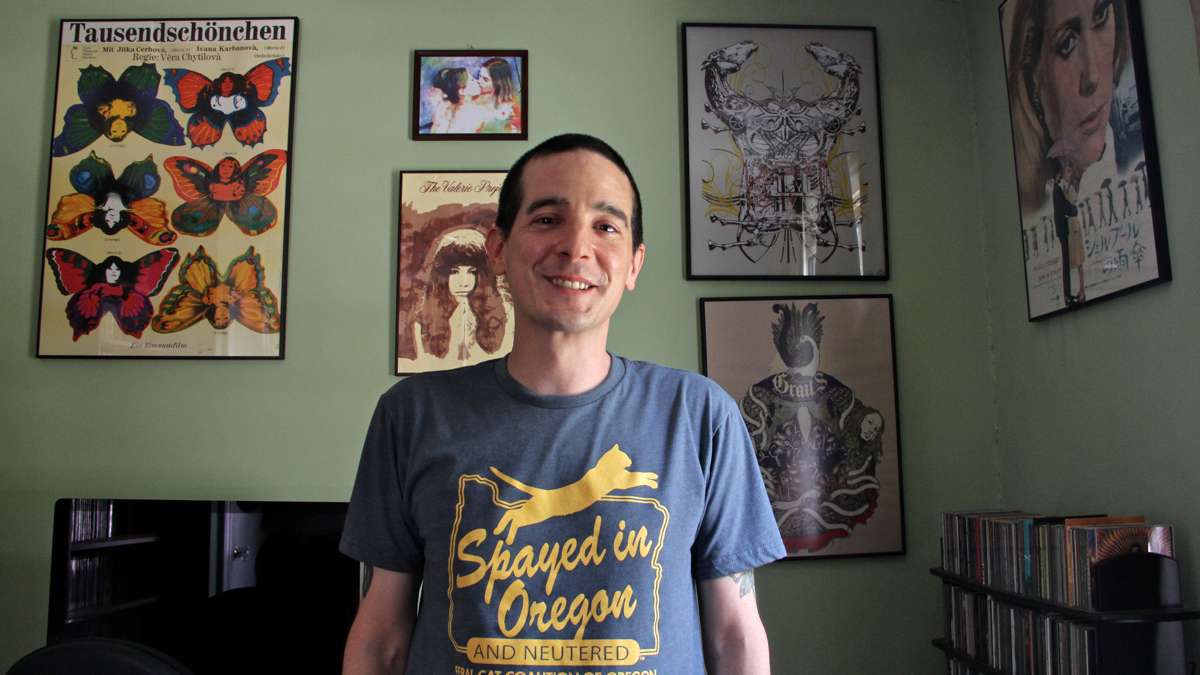How old Fringe projects stay afloat, literally
Listen-

Mary Mattingly's WetLand, a floating exhibit featured in the 2014 Fringe Festival, has been drydocked at a South Jersey Marina. (Emma Lee/WHYY)
-

WetLand is a floating sculpture resembling a partially submerged rowhome. At the 2014 Fringe show it was a model of sustainability, featuring rainwater collection and purification, greywater filtration, dry compost systems, and food production. (Emma Lee/WHYY)
-

Mary Mattingly hopes to refloat WetLand at Bartram's Gardens, where it would be used as a space for classes, residencies, and public programming. (Emma Lee/WHYY)
-

For the 2006 Fringe Festival, Joseph A. Gervasi came up with The Valerie Project. He and musician Greg Weeks presented a Czech film with a new live musical score. (Emma Lee/WHYY)
-

e The film, Valerie and her Week of Wonders, has since been re-released, making use of the soundtrack written for the Fringe show. (Emma Lee/WHYY)
The annual Fringe Festival begins next week, when more than 150 performance pieces will be staged throughout the city.
Some will be brilliant, some won’t be. Most will disappear as soon as the curtain drops.
Is there life after Fringe?
Act I
This is how a lot of performing artists approach the Fringe: Put a great deal of effort developing a piece, debut it at the festival, then try touring other cities to extend the life of the piece.
That is the model Pig Iron Theatre has been working successfully for many years. This year the company is working with the band Dr. Dog to create a performance that exists somewhere between a rock concert and experimental theater. “Swamp Is On” is an attempt to bring the audience into communication with another dimension.
It’s weird. But weirder still is trying to package the show for the road.
“Everybody would be excited to do the show several more times, including Dr. Dog,” said Dan Rothenberg, co-artistic director of Pig Iron. “One of the things that is expensive with both theaters and concert venues is time in the space with technical people – the riggers, the lighting folks. Add a day, and you double your expenses. Can we take this concept and get more nimble – instead of loading in in 2 ½ days, can we load in in ½ day?”
Members of Pig Iron and Dr. Dog have known each for a long time, and the idea of “Swamp is On” has been swirling around for years. It is coming together this fall fairly quickly: an advanced program schedule for the Fringe, which was circulated to the press, did not list the show, but it was added at the last minute to the printed program now available to the public.
The show will be performed at Union Transfer, and the first, and most crucial, decision to be made was: Will the audience be sitting down, or standing up? To the audience perspective, sitting means this is theater, standing means it’s a concert. The audience will be standing, and the most of the music are songs Dr. Dog is working up for its next album release.
There will be actors, props, and sets, but not a cohesive story arc. There will be guitars, amps, and songwriting, but the band will perform under the pseudonym The Dr. Dog Pop Detachment. Rothenberg said it’s not a rock opera, and it’s not proper theater. He does not have a succinct way to describe it to audiences, nor to presenting venues who might consider taking it on.
“This is different,” he said. “It will cost more, but it’s interesting.”
Act II
Last year, artist Mary Mattingly built a boat that resembled a sinking rowhome. Called WetLand, it was moored on the Delaware River near the popular Spruce Street Harbor Park, with its own floating vegetable garden, a beehive, a chicken coop. WetLand was a homesteading experiment dressed as a metaphor for underwater mortgages.
“It was designed to be lived in,” said Mattingly. “It’s a habitat that provides more than shelter.”
Since the Fringe, WetLand has been dry-docked at a small boat storage marina in Westville, New Jersey, on the bank of Big Timber Creek. The 45-foot boat is on blocks a few feet from a nautical graveyard, where other boats that have succumbed to the elements. Mattingly, based in New York, is figuring out the second act of her floating metaphor. She is doing some upgrades.
“I just started working on it again,” said Mattingly, taking a break from the power drill. “It’s getting better and better. It’s going to be better than the Fringe Festival.”
Mattingly is putting on new solar panels for power, and has tinkered with the boats problematic water system. She will soon be towed up the Schuylkill River, to the Walnut Street Bridge, where a group of students from the University of Pennsylvania will use it as a home base for a new academic program, the Penn Program in the Environmental Humanities. Students will use the boat to hold environmental workshops, stage sustainability experiments, and host public events.
WetLand will then depart for a gig at the Parrish Museum in Long Island. Sometimes next yet it will return to Philadelphia to dock at Bartram’s Garden.
“A lot of projects I’ve done in the past have been temporary – we’ve had to rent or borrow something, and at the end dismantle the ecosystem,” said Mattingly, whose work is often about environmental issues. “Here, we’re able to keep building it and using it in different places and times and different people.
Act III
In 2006, a band called The Valerie Project formed from members of several other Philadelphia rock bands, mostly the Espers and Fern Knight. Greg Weeks (Espers) wrote an alternative soundtrack to an obscure, surreal Czechoslovakian film called “Valerie and her Week of Wonders” (1970).
He worked off a 16mm print, with subtitles, owned by Joseph Gervasi, a cult film guru who runs Diabolik DVD and Exhumed Films. The fact that the print already had subtitles meant the band could turn off the existing soundtrack entirely – with all music, dialogue and sound effects – and run the film only with live music.
“There is a plot structure, but it’s mostly a visual film,” said Gervasi. “The film could work like a music video – the power of the images alone could convey the story, and by adding different music you could alter how one views the film.”
They performed the soundtrack live to a screening of the film at the International House in University City. It was a Fringe Festival premiere.
“The Fringe was a single performance. It sold out,” said Gervasi, who produced the show. “The thought was, this should happen again. Too much work went into this process.”
So Gervasi took the act on the road. The eleven musicians played California, Canada, twice in New York, and once at the Royal Festival Hall in London, for the annual Meltdown Festival.
Then, it just stopped.
“‘The Valerie Project’ was a behemoth,” said Gervasi. With 11 musicians, two cellos, a concert harp that required it’s own van, the logistics and costs of touring the show was too much. Nine years after its debut at the Philly Fringe, it would be nearly impossible to round up the musicians to stage the show again.
Nevertheless, the Valerie Project has gotten its third and final act, on DVD.
The Criterion Collection has released “Valerie and her Week of Wonders” on disc. Considered by many to be the gold standard of DVD releasing, it features a digital copy of the film struck from the original 35mm negative, digitally restored frame-by-frame, early short films by the director Jaromil Jires, a booklet essay by film scholar and pet Jana Prikryl, and the complete Valerie Project soundtrack as an audio option.
“It has a folk feel, an earthy, hypnotic quality,” said Curtis Tsui, the producer of the Criterion release. “Their music style – while different from the score by Lubos Fiser – was oddly appropriate. When you listen to it you get an entirely different take on the movie, and yet it makes sense.”
Criterion is not the first to put the Valery Project on disc. A German DVD release of the film also included the optional soundtrack, though without English subtitles and not coded for American DVD players. In 2007, Drag City Records released the soundtrack as an audio CD.
Gervasi believes the Criterion release is the best imaginable ending for The Valery Project.
“Once the Criterion Collection is released, that is the ultimate incarnation this film is going to have,” said Gervasi. “I mean, that’s it.”
WHYY is your source for fact-based, in-depth journalism and information. As a nonprofit organization, we rely on financial support from readers like you. Please give today.





